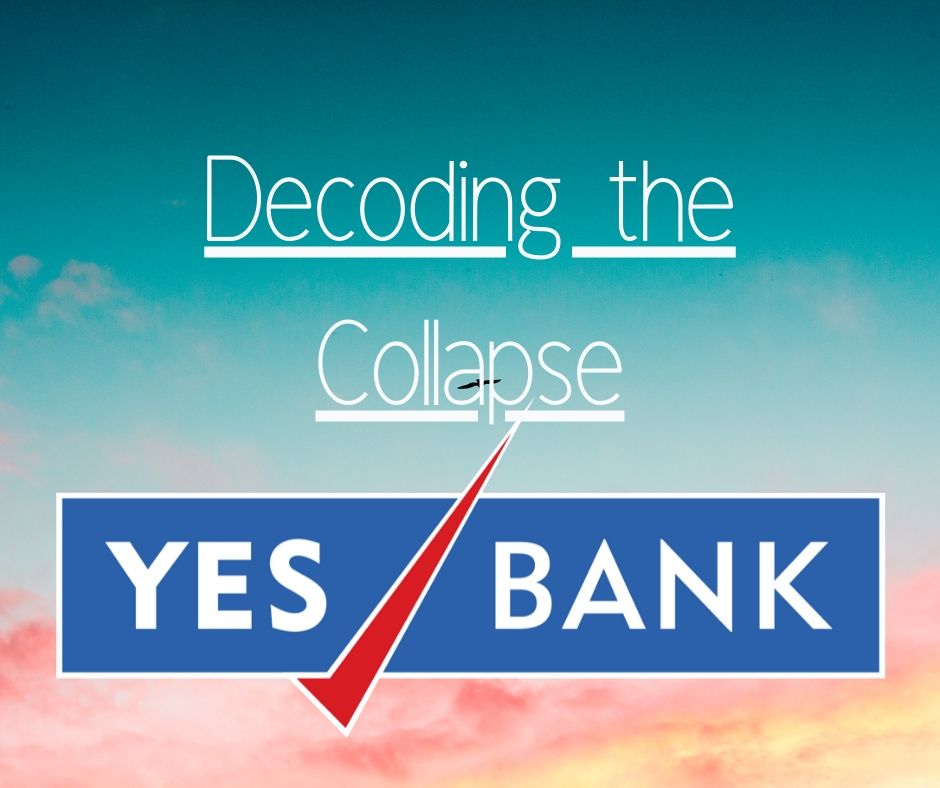Yes Bank: Collapse Full Case Study | Are banks Safe in India?
- 7 April 2020 | 4412 Views | By Abhinav Mishra

The rise and downfall of Yes Bank, has certainly created a lot of examples in various dimensions in the fields of economics and finance. From detailing with credit, market, operational and reputational risk, to being known as a classic example of government aided rescue, this mishap has left something to think about for every investor and customer.
During its rise, Yes Bank was accoladed by several national and international awards. Aggressively open to new ideas and technologies, several startups have banked upon Yes Bank and its services. Some of the top mutual funds and FII’s regarded Yes Bank as the apple of their eye.
Attractive interest rates and smooth services, assured the bank to have young generation as well as senior citizens as its loyal customers. In less than two decades, it had achieved those pinnacles of success, which several private and government banking companies had dreamt of.
It’s downfall, has been avalanche. From having moratorium imposed by the Reserve Bank of India, to infusion of capital by competitor banks and locking of 75% equity shares for a period of -3- years, a lot remains unexplored and undecided for Yes Bank.

How did it ended up like this? From a wealth creator to eroder, what made this valuable private bank lose it’s worth? Are Indian banks going to collapse, eventually? We shall explore answers to these questions and more in this article.
Yes Bank: The Beginning
The Bank was founded in 1999 by three successful bankers – Ashok Kapur, Harkirat Singh, and Rana Kapur. Ashok Kapur was the former country head of the ABN Amro Bank, Harikat was former country head of the Deutsche Bank while Rana was former corporate finance head of the ANZ Grindlays Bank.
These three held 25 percent shares in the non-banking financial corporation while the remaining 75% were with the Rabo Bank of the Netherlands. It became Yes bank in 2003, in the same year Harikat quitted the Yes Bank over issues with RaboBank. The bank went public in the year 2005 and started making steady progress in the initial years.
The first shock in the story of Yes Bank came in the year 2008 when Ashok Kapur who was the chairman of the company died in the terrorist attack on the Trident Hotel which was one of the targets of the 26/11 attack. This changed a lot within the bank.
It is also important to mention that Rana Kapur is married to the sister of Madhu Kapur (wife of Ashok Kapur). After the death of Ashok Kapur, the battle of supremacy started in Yes Bank. Rana Kapur was in full control of the bank by now. Madhu Kapur tried very hard to get her daughter on the board of directors but she failed in her two attempts in 2009 and 2011. The battle continued for the next 4 years and was finally settled in 2015 when Kapurs got seats in the board of directors.
Banking Strategies
In this period of the internal war, the bank went aggressive with lending. The bank was still growing but the first issue came in July 2015 when one of the major global financial services firms, UBS reported that the bank had the strongest growth in loans to potentially stressed companies.
Over the coming years, the bank started losing the trust of the common people as well as investors. The second biggest shock in Yes Bank’s dramatic story came in August 2018 when RBI asked its chief executive, Rana Kapur to quit the bank by January 31, 2019. By then, It was known to many that the major problem in the governance of the bank was Rana Kapur. Ravneet Gill was appointed as the new chief executive of the fourth largest private bank in India before it collapsed. The bank reported its first loss during March 2019 quarter and since then it is continuously reporting losses.
Why did Yes Bank Collapse?
While several reasons ensemble to reason with the failure of the Bank, the following few are most prominent ones.
Poor Loan Policy
The primary reason why banks lend money is to make money by charging interest. Non Performing Asset refers to loans that are in arrears or default. A loan is said to be in default when the interest or principal payments are missed or are late. The biggest reason for the collapse of the Yes Bank is poor loans. As per the reports, the bank has granted loans to all the poor companies in the market.
They have lent huge money to companies like IL&FS, Jet Airways, Dewan Housing, Cox & Kings, Cafe Coffee Day and CG Power. The bank lent money on easy terms without checking the financial health of the companies which helped the bank to make a profit in the beginning but eventually led to collapse. Most of these companies are bankrupt or are reporting negative growth in recent quarters. It is impossible for any bank to survive with so much NPA. Yes Bank was no different.
Financial Position
On one hand the bank was suffering from NPAs, on the other hand, it was unable to raise fresh capital which resulted in rating downgrades, loss of faith of investors and withdrawal of deposits. In the last one year, the bank has made inadequate profits and huge losses.
Governance Issue
As per banking reports, ever since Rana Kapur got the complete ownership of the bank, the bank started disbursing poor loans. The bigger issue was that the bank under-reported NPAs to the tune of Rs 3277 crore in the financial year 2018-19. This prompted RBI to send R Gandhi (a former Deputy Governor) to the board of the bank. After the PMC bank crisis, it was quite certain Yes bank will also sink but neither the directors of the bank nor the management tried to save the bank.
Was there Mishandling of the Economy by the Government
As mentioned in the last point, RBI appointed a member in the board of directors but he overlooked the problem for a long time and did not ring the alarm bell in time which was the main purpose for which he was onboarded. P Chidambaram, the former finance minister stated the current government’s mishandling of the economy is one major reason for the collapse of the bank, the bank which was a success story in Indian private banking space till a few years ago. He also said that the current government is in power for 6 years and their ability to regulate and govern financial institutions stands exposed.
False Assurance
When Rana Kapur was removed as chief executive, he was very vocal about the bank. He said in multiple interviews that Yes Bank is a gem and neither he nor his family members would ever sell a single share of the bank. Who would have known the position of the bank better than him? In the coming months, he sold most of his shares in the open market. Also, whenever RBI asked the management about the fresh investment, the bank always convinced RBI that the bank is in talks with various investors and will be successful very soon. This never happened as there was no concrete proposal from investors to put in money in the bank.
Investor’s issue
The bank has been trying to raise capital from various investors over the past year. There was news coming every now and then that they have been successful in raising the money but the official statement never came. The investors had a discussion with officials of Reserve Bank on various issues and for checking legalities but none of them eventually infused any capital in the bank. It shows the investors were not serious about investing in the bank. By February 2020 it was clear Yes Bank won’t be able to raise capital which was the only way it could have survived.
Sluggish Economic Sector
The Indian financial sector has been passing through a slag period. Indian authorities are struggling to contain the shadow lenders and lending for riskier businesses which has choked credit to small businesses and consumers which in turn have slowed economic growth to 11 years low. Fitch Rating services, in its 2020 outlook for ‘Asia-Pacific Emerging Market Banks’ has maintained a negative outlook on the Indian banks.
The Liquidity Risk
The bank had lost the trust of the investors, as a result, its share price fell from Rs 393.20 on 17 August 2018 to Rs 42.15 on 4 October 2019. This led to customers losing faith in the bank. The bank started witnessing withdrawal of deposits from customers and for the same reason, RBI had put a cap on the withdrawal. At the end of September 2019, the bank had the deposit book of Rs 2.09 lakh crores.
The Present scenario & Future
Since the bank failed to raise capital from the investors, RBI had to come to its rescue. The Reserve Bank of India has come out with a scheme to revive Yes Bank by bringing in India’s largest bank in the picture. State Bank of India is going to make an investment in Yes Bank and the process has already started. SBI is investing 49% in Yes Bank and the new Yes Bank will have 6 members Board. The services of several key management personnel (KMP) can be discontinued at any point after following due procedure by the board, if it feels the need.
RBI said, “The Authorised Capital shall stand altered to Rs.50,00,00,00,000 (Rupees Five thousand crores only) and a number of equity shares will stand altered to 24,00,00,00,000 (two thousand four hundred crores only) of Rs.2/- (Rupees Two only) each aggregating to Rs.48,00,00,00,000 (Rupees Four thousand eight hundred crores only).”
The investor bank i.e State Bank of India will not be allowed to reduce its holding below 26% till the next three years from the date of infusion of capital.
All the employees of the bank will continue in the service of the reconstructed bank for at least one year with the same terms and conditions.
The existing infrastructure of the bank will not change and will function in the same manner without being affected by the scheme. The bank is free to open/close new offices, branches in compliance with RBI’s norms.
As per experts, Reserve Bank of India should have come in the picture a little earlier. Not only that, but there are also multiple issues involved in getting SBI to bail out this bank and these are unlikely to go away in the near future. But at least now there is a hope of its revival and RBI is continuously monitoring the progress. We hope the bank recovers soon because its failure will make a big dent in the Indian banking system.









